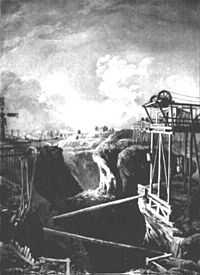Dannemora, Sweden
| Dannemora | |
|---|---|
 Dannemora | |
| Coordinates: 60°12′23″N 17°51′48″E / 60.20639°N 17.86333°ECoordinates: 60°12′23″N 17°51′48″E / 60.20639°N 17.86333°E | |
| Country | Sweden |
| Province | Uppland |
| County | Uppsala County |
| Municipality | Östhammar Municipality |
| Area[1] | |
| • Total | 0.66 km2 (0.25 sq mi) |
| Population (31 December 2010)[1] | |
| • Total | 213 |
| • Density | 325/km2 (840/sq mi) |
| Time zone | CET (UTC+1) |
| • Summer (DST) | CEST (UTC+2) |
Dannemora is an old mining town and a locality situated in Östhammar Municipality, Uppsala County, Sweden with 213 inhabitants in 2010.[1]
Dannemora mine

Dannemora is the location of an important iron ore mine, the Dannemora mine, which formed the basis of the iron industry in Uppland. It provided the raw material for about 20 finery forges that produced bar iron for export. In England, iron produced from Dannemora ore, was known as oregrounds iron, after the port town of Öregrund. Bar iron from these forges was considered the best raw material for producing blister steel by the cementation process, owing mainly to the extremely low levels of sulphur and phosphorus in the ores but also to the relatively high manganese content.
In 1878 the narrow gauge (891 mm) Dannemora–Hargs railway was opened to the port in Hargshamn, and iron ore started to be exported directly.
The mine was closed down in 1992. With world market demand rising again, the feasibility of reopening the mine was investigated. The mine was re-opened in June 2012 in a ceremony performed by King Carl XVI Gustaf.
See also
References
- ↑ 1.0 1.1 1.2 "Tätorternas landareal, folkmängd och invånare per km2 2005 och 2010" (in Swedish). Statistics Sweden. 14 December 2011. Archived from the original on 10 January 2012. Retrieved 10 January 2012.
External links
| ||||||